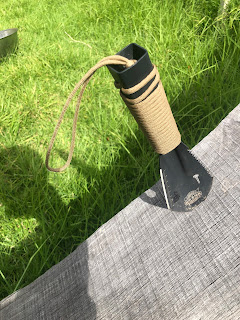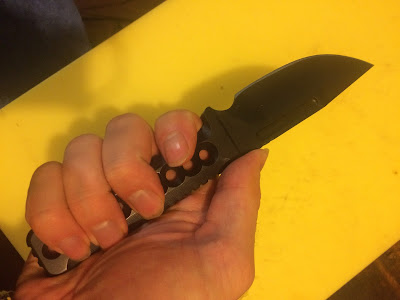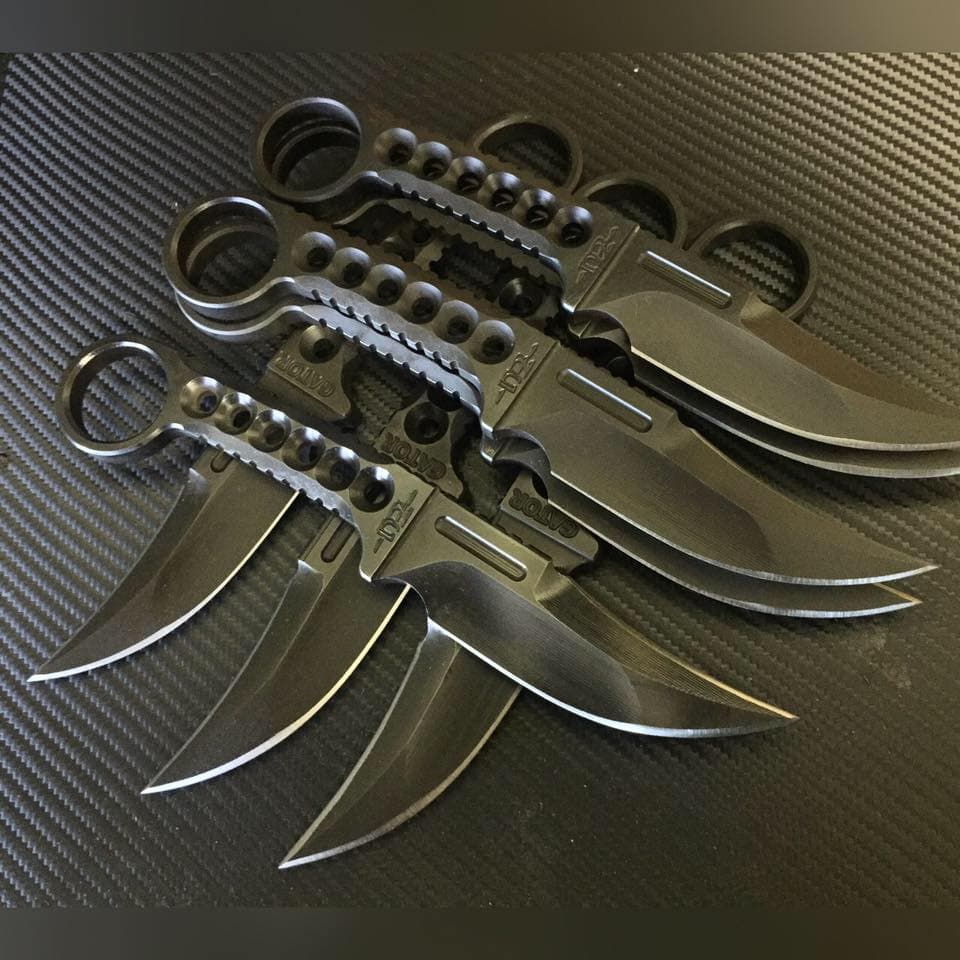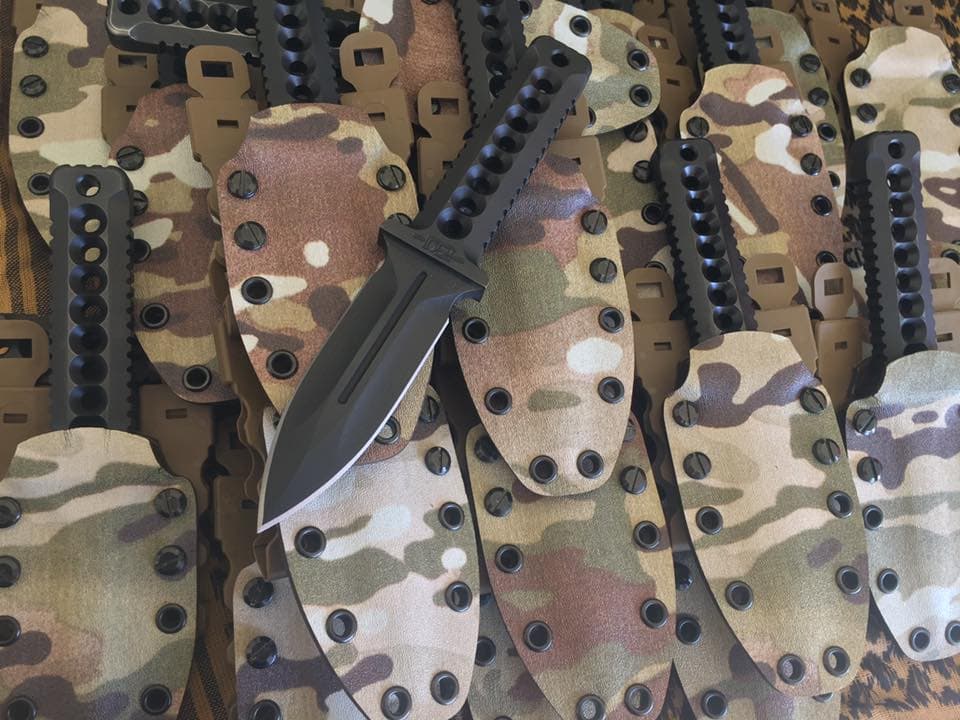Here's a guest post, in conjunction with the good folks of Breach Bang Clear!
Sean O’Hare Knives has been making custom knives since 2001, and Sean began doing it full-time in 2009. He hails from Canada, and he is also a very skilled photographer. Sean makes fixed blade knives, including drop point hunters and tactical tantos, and folding knives, including flippers. If you’re into knives, you owe it to yourself to look him up on the ‘net and check out his knife creations. They are utterly beautiful, both in form and function. A Sean O' Hare knife can be very dressy and ornate, while others are simply well-executed and practical. For certain, he makes something for every taste that’s out there.
The fit and finish of his knives are extraordinary, whether we’re looking at the dressier knives or the knives intended for more hard, practical use. He prefers G10, stabilized woods, and Micarta for handle material on his fixed blades. He uses the stock removal method.
The grip fits most hand sizes like a glove!
The Badger Model
I have an example of one of Sean O' Hare's knives that I’ve owned for quite some time, over ten years. The Badger model falls under the tactical class of knives, although it could certainly be used for a host of duties, including Bushcraft/Survival, defense, hunting, or knife reviews.
Blade
The blade of the Badger is made from CPM 154CM steel and is approximately 4 ½ inches long, although the choil adds a bit of length (I did not count the choil portion as part of the blade). Blade configuration is of the drop point variety. The blade stock is somewhat thick and stout, but the flat grind lends this blade as an excellent slicer. The CPM 154CM steel is not the latest, greatest wonder-steel, but it is a solid performer that’s been around for quite a while. Its virtue is that it is relatively easy to sharpen and holds an edge for a decent time under use. I’ve been delighted with it.
The Badger in its natural environment. Note the
striking pommel.
Pommel and Handle
A guard is built into the knife in front of the handle to keep the hand from sliding up onto the cutting edge. In front of that is the aforementioned choil, which is helpful if the user wants to choke up on the knife for added control during finer cutting chores. The handle of the Badger is full tang, and it has a triangular striking pommel at the butt of the handle, complete with a lanyard hole and jimping. The pommel edges were sharp and tended to abrade my side when I carried the knife, so I took a diamond stone to them and rounded off the edges ever so slightly, fixing that issue. However, it would still be very effective as a striking surface.
Holding the handle on are three mosaic pins that go all the way through, securing the scales solidly. The handle is made from smooth dark green canvas micarta, yet it provides enough traction for a positive purchase. It allows the hand to slide around enough to reduce friction and eliminate “hot spots” when chopping with the knife so that there is no discomfort to the user. At the same time, the knife is not likely to slip out of the hand during use. Sean got this aspect spot on! In addition, the shape of the handle fits wonderfully into the hand, filling the hand well but not being so large as to be uncomfortable. Several people have tried the knife and, despite having various sized hands, each remarked that it felt as though the knife had been made just for them.
There is jimping on the spine of the blade, where the thumb is placed, which does a perfect job of anchoring the thumb to that spot while not being overly abrasive to the skin.
Sean O' Hare Knife Feel and Finish
In the hand, this Sean O' Hare knife has the most “lively” feel of any fixed blade I’ve ever handled. Not to sound corny, but it almost strikes me as “magical,” the balance, weight, and configuration just become a perfect extension of my hand when gripped. The knife’s weight is 6.2 ounces, and I’m sure the low weight contributes to the liveliness in the hand. The balance point is right where the handle ends, and the guard begins, making the balance perfect. Sean did his homework on this point, and the finished product reflects that.
The finish of the metal appears to be hand-rubbed satin, which gives a pleasing appearance. The overall fit and finish of this knife is outstanding.
Personal Opinion
For years now, this has been my go-to fixed blade when I’m venturing into the outdoors and deciding to have a fixed blade with me. I would feel very comfortable using this knife for camp chores or other woodland tasks such as building a shelter.
A great carry package for woodland jaunts. Fixed
blade Badger, Spyderco Native, and Glock 43X.
Beyond that, I look at this blade as a serious defensive tool if it ever came to that. Let’s face it, if we ever have to use a Sean O' Hare knife to defend ourselves, we’re having an exceedingly bad day, but it is what it is, and I like to be prepared for all eventualities. And these days, one never knows what sort of misadventures might rear their ugly head. Knives never run out of ammo, if you know what I mean. And they’re relatively silent in operation. This particular knife would work great for defense, given its lightweight and nimbleness in hand.
The Badger is not huge, nor is it small, by any means. I’d call it slightly larger than medium-sized. It’s not something I conceal on my person when going about my daily travels. But for hiking and the like, it is just what the doctor ordered.
Here the belt clip can be seen. Clipping onto
and off a belt is quick and easy, but the sheath is held securely once clipped
on.
Sheath and Sharpness
A word about the sheath: it is simple and excellent. Period. It consists of a piece of Kydex folded over and secured with rivets that allow cordage to pass through them if you want to lash it to a part of your kit. It has a belt clip that slips over your belt and hooks over it so that when you draw the knife, the sheath will not follow (see the photos, my description may not be the best here). It can be donned or removed quickly and easily yet remains secure when it’s on your belt. Tension retains the Badger in the sheath until it is drawn out.
The Badger in its sheath is a compact carry
package.
How does it cut? Fabulous! Light wood cutting, chopping small branches, slicing through paracord, and a myriad of other tasks, passed with flying colors. However, it’s not a blade that I use regularly; I have smaller folding knives as my workhorses. Instead, the comfort that this blade provides simply by being there on my side makes it golden because I know it will perform, and it’s dependable when needed.
Final Thoughts
On top of all of what I listed above…this Sean O' Hare knife is simply a work of art. There’s no other way to put it, it just looks fantastic on top of being a functional piece of gear. Sean O’Hare is a real artist when crafting sharp, pointy things. If you haven’t checked out his cutlery, jump on the internet and look him up. Be aware, though, his knives are very much in demand, so it’s not certain if he will have inventory lying around ready to go out the door. There may be a bit of a wait, but I can personally tell you that it is worth it! There’s just something about holding a hand-made tool like this in your hand that gives a feeling of satisfaction.
These days, his fixed blade knives seem to be in the $425-$450 price range, but don’t quote me on that. Check ’em out, you won’t regret it!
About the
Author:
Jim Davis served in the PA Dept. of Corrections for 16 ½
years as a corrections officer in the State Correctional Institute at
Graterford and later at SCI Phoenix. He served on the Corrections Emergency
Response Team (CERT), several of those years as a sniper, and also the Fire
Emergency Response Team (FERT). For 25 years, he was a professional instructor,
teaching topics including Defensive Tactics, Riot Control and Tactical
Operations, Immediate Responder, and cognitive programs as an adjunct
instructor at the DOC Training Academy. He was then promoted to the title of
corrections counselor, where he ran a caseload and facilitated cognitive therapy
classes to inmates. His total service time was close to 29 years. He was
involved in many violent encounters on duty, including multiple unfortunate
incidents of fatalities. He is a regular contributor to the KEEN
INSIGHTS column on The Mag Life.
 This little beauty is the ChinLin HW-901 spade and I originally picked a couple up on Wish.com but it looks like they are no longer sold there. I did find them on this Indonesian clone ( buyer beware). What it is is a 26.3cm ( 10 1/3") trowel with a para-cord wrapped box handle. Made from a single piece of 420 Stainless steel, the handle has been welded along the middle of the upper face, obscured by the cord wrap. The trowel has a sharpened edge around 3/4 of its edge, with the final quarter being a serrated saw-edge. The spoon face of the tool has a nail puller cut in as well as a set of four hex-head wrench cut-outs.
This little beauty is the ChinLin HW-901 spade and I originally picked a couple up on Wish.com but it looks like they are no longer sold there. I did find them on this Indonesian clone ( buyer beware). What it is is a 26.3cm ( 10 1/3") trowel with a para-cord wrapped box handle. Made from a single piece of 420 Stainless steel, the handle has been welded along the middle of the upper face, obscured by the cord wrap. The trowel has a sharpened edge around 3/4 of its edge, with the final quarter being a serrated saw-edge. The spoon face of the tool has a nail puller cut in as well as a set of four hex-head wrench cut-outs.  The edges aren't super-sharp but they're sturdy enough to chop with, which will be good for clearing brush, weeds or stubborn roots whilst digging. Weighing in at only 80g (2.8oz) it's not going to cut it as an axe, but it makes for a lively and light digging tool. The sharp edges and serrations do make digging through turf easy, and the tool-cut-outs don't effect digging and scooping output significantly.
The edges aren't super-sharp but they're sturdy enough to chop with, which will be good for clearing brush, weeds or stubborn roots whilst digging. Weighing in at only 80g (2.8oz) it's not going to cut it as an axe, but it makes for a lively and light digging tool. The sharp edges and serrations do make digging through turf easy, and the tool-cut-outs don't effect digging and scooping output significantly.















































